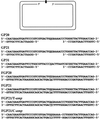Quantitative measurement of translesion replication in human cells: evidence for bypass of abasic sites by a replicative DNA polymerase
- PMID: 11891323
- PMCID: PMC122598
- DOI: 10.1073/pnas.062038699
Quantitative measurement of translesion replication in human cells: evidence for bypass of abasic sites by a replicative DNA polymerase
Abstract
Mutations in oncogenes and tumor suppressor genes are critical in the development of cancer. A major pathway for the formation of mutations is the replication of unrepaired DNA lesions. To better understand the mechanism of translesion replication (TLR) in mammals, a quantitative assay for TLR in cultured cells was developed. The assay is based on the transient transfection of cultured cells with a gapped plasmid, carrying a site-specific lesion in the gap region. Filling in of the gap by TLR is assayed in a subsequent bioassay, by the ability of the plasmid extracted from the cells, to transform an Escherichia coli indicator strain. Using this method it was found that TLR through a synthetic abasic site in the adenocarcinoma H1299, the osteogenic sarcoma Saos-2, the prostate carcinoma PC3, and the hepatoma Hep3B cell lines occurred with efficiencies of 92 +/- 6%, 32 +/- 2%, 72 +/- 4%, and 26 +/- 3%, respectively. DNA sequence analysis showed that 85% of the bypass events in H1299 cells involved insertion of dAMP opposite the synthetic abasic site. Addition of aphidicolin, an inhibitor of DNA polymerases alpha, delta, and epsilon, caused a 4.4-fold inhibition of bypass. Analysis of two XP-V cell lines, defective in DNA polymerase eta, showed bypass of 89%, indicating that polymerase eta is not essential for bypass of abasic sites. These results suggest that in human cells bypass of abasic sites does not require the bypass-specific DNA polymerase eta, but it does require at least one of the replicative DNA polymerases, alpha, delta, or epsilon. The quantitative TLR assay is expected to be useful in the molecular analysis of lesion bypass in a large variety of cultured mammalian cells.
Figures


References
-
- Friedberg E C, Walker G C, Siede W. DNA Repair and Mutagenesis. Washington, DC: Am. Soc. Microbiol. Press; 1995.
-
- Reuven N B, Arad G, Maor-Shoshani A, Livneh Z. J Biol Chem. 1999;274:31763–31766. - PubMed
-
- Masutani C, Kusumoto R, Yamada A, Dohmae N, Yokoi M, Yuasa M, Araki M, Iwai S, Takio K, Hanaoka F. Nature (London) 1999;399:700–704. - PubMed
-
- Johnson R E, Kondratick C M, Prakash S, Prakash L. Science. 1999;285:263–265. - PubMed
Publication types
MeSH terms
Substances
LinkOut - more resources
Full Text Sources
Other Literature Sources
Research Materials
Miscellaneous

